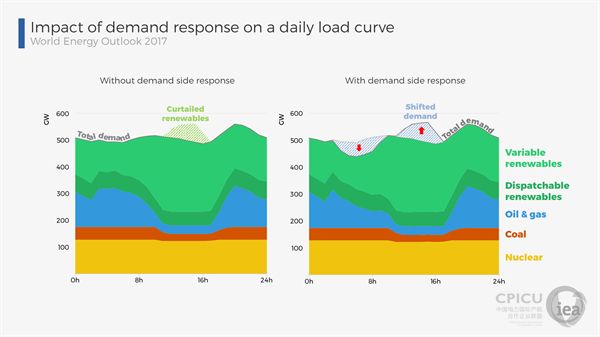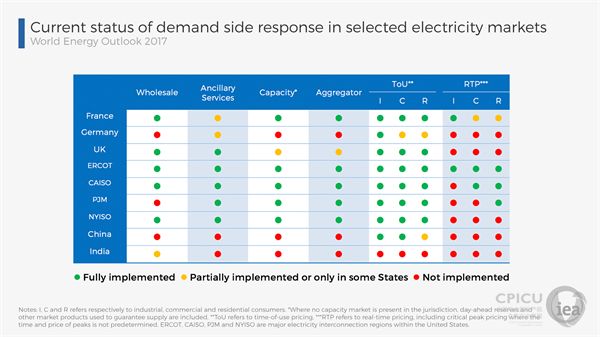
Over 75% of the global potential in demand-side response lies in buildings, with space heating, water heating and air conditioning loads contributing the most (Photograph: Getty Images)
The following commentary was written by WEO Energy Analysts Stéphanie Bouckaert, Timothy Goodson and Brent Wanner.
As a fundamental rule, electricity supply and demand must be balanced at all times. Traditionally, this has been achieved by adjusting electricity supply to match demand that varies at different times of the day. But this poses a problem as the share of power generation from variable renewables such as wind and solar PV rises. Demand-side response is one of several measures that can help integrate higher shares of variable renewables, including electricity storage, greater interconnection and more flexible power plants.
When the sun is shining and the wind blowing, electricity generation from these sources may exceed demand, leading to the curtailment of otherwise low-cost and carbon-free electricity. Inversely, when the wind doesn’t blow or on cloudy days, power systems may need to rely on flexible yet expensive and carbon-intensive sources of generation. Both of these outcomes are economically and environmentally undesirable.
Demand-side response can significantly reduce such outcomes by shifting and shaping electricity demand to match the availability of renewables-based electricity generation.

Traditionally demand-side response has been confined to large-scale industrial consumers manually shedding demand in times of system stress. But over 75% of the global potential in demand-side response lies in buildings, with space heating, water heating and air conditioning loads contributing the most. The thermal inertia of buildings and hot-water storage allows electricity demand from heating and cooling equipment to be shifted in time to suit the needs of the grid at low cost without compromising user comfort. Loads from appliances such as refrigerators and washing machines can also become demand-side response resources, facilitated by the growing market share of smart appliances.
Expanding demand-side response – beyond manual shedding of large loads – is a relatively recent phenomenon, with Europe and the United States currently leading growth. In several markets consumers can receive payment for various forms of short-duration “fast frequency response” to keep the grid in balance, larger volumes of “load shifting” to respond to changeable weather, or contracts for guaranteed changes to future consumption patterns.

In addition to balancing loads, demand-side response measures can provide benefits to the grid by mitigating congestion in transmission and distribution systems and delaying or avoiding network upgrades, resulting in important savings. Power systems with greater flexibility are also better able to respond to short-term variations in electricity supply or demand that can be created by sudden changes in output from variable renewables-based generators.
The flexibility provided by demand-side response is therefore both a valuable resource facilitating the integration of a high share of variable renewables, and a symbol of the shift away from the traditional paradigm of supply following demand.
Identifying demand-side response potential
Globally, the theoretical potential of demand-side response today is estimated to be nearly 4,000 TWh per year, or more than 15% of total electricity demand (WEO 2017). Based on IEA modelling of electricity consumption profiles by end-use, this potential represents the sum of all loads than can be shifted for every hour of the year.
In the central scenario of the World Energy Outlook 2017, annual demand-side response potential is expected to increase to almost 7,000 TWh by 2040, the buildings sector leads future growth as demand for appliances and electric heating and cooling expands in Asia and Africa. Within developed economies, the electrification of heating and transport are major drivers of future growth. Smart charging of electric vehicles (EVs) uses charging (and discharging) of EV batteries to facilitate balancing of the power grid.
The IEA estimates that by 2040 almost 1 billion households and 11 billion appliances could participate in demand response programmes. While the majority of potential may lie in buildings, this potential can also be the most difficult to tap. This is especially the case in residential buildings, where participating in demand-side response programs may require behaviour change while offering limited economic benefits to households due to the small size of residential loads. As such, aggregation and automation of small scale demand-side response resources is often the most viable path to market for the residential sector.
The demand-side response potential in industry and large commercial buildings can be more accessible, as energy management systems optimize decisions to consume electricity or offer demand-side response services to the market.
Connectivity as a key enabler
Digital connectivity is the key to expanding demand-side response into new sectors and realising a greater share of its total theoretical potential. By enabling the linking, monitoring, aggregation and control of large numbers of individual pieces of electricity consuming equipment, connectivity allows for matching demand to the needs of the overall system in real time (Digitalization & Energy, 2017). Smart meters, smart appliances, electric vehicles and load management software are therefore central to efforts to increase demand-side response resources.
Capitalizing on demand-side response potential also requires appropriate price signals and regulatory frameworks to incentivize participation. Retail tariff structures such as time-of-use pricing or real-time pricing can deliver the necessary price signals to consumers, while enabling aggregators and other demand-side resources to participate in wholesale energy, capacity and ancillary services markets can create the necessary environment to stimulate investment.
Demand-side resources active in markets today represent only the tip of the iceberg in terms of the total potential. Digitalisation presents an opportunity to unlock this enormous potential and significantly enhance grid flexibility. As prices for digital technologies continue to fall and electricity consuming equipment is increasingly connected and controllable, expansion of demand-side response becomes technically feasible and economically attractive.
Electricity consumers benefit from reduced electricity bills by providing demand response services, but even larger savings are realised on a system level. Digitally enabled demand response is often a more cost-effective and climate-friendly measure facilitating the integration of variable renewables than building new power plants or electricity storage. Rapid expansion will act as a key accelerator for the clean energy transition. Moving forward, government policy will need to provide clear rules and a long-term vision for increasing demand-side response resources.
Demand-side response and the integration of variable renewables in power systems are analysed in a number of IEA publications, including the World Energy Outlook 2017, Digitalization & Energy and the special focus on renewables in the World Energy Outlook 2016.

